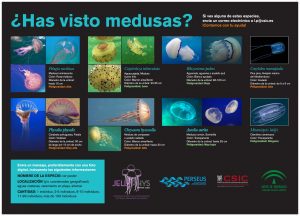Jellyfish are beautiful marine beings that have been wandering around our seas for more than 500 million years. The jellyfish have a symmetrical body and have no brain, but through their nerve receptors allows them to identify any possible prey or food that is around you. Both males and females can release ovules and sperm at the same time, which facilitates their survival. The jellyfish can live up to 6 months, and only the Turritopsis Nutricula, never dies, is immortal.
Above all, in the summer you have to pay close attention to the beach in the presence of jellyfish since their bites can cause serious damage to our skin.
During the last years there has been a great increase of jellyfish due to the decrease of predators, mainly turtles and big fish, to the warming and contamination of marine waters.

What to do after a sting of a jellyfish ?
The most dangerous jellyfish in the Mediterranean are the luminescent jellyfish, the marine hornet and the Portuguese caravel.
If you have been stung by one of them, the first thing you should do is protect your hands with gloves, or use tweezers, to remove the tentacles of the animal that could have been on the skin of the affected person. As much as it stings, you should not scratch or rub the affected area.
It is best to remove those tentacles with seawater, or physiological saline if you have it on hand. Then, you must apply compresses wet with cold water in the affected area, between 30 and 60 minutes. Do not forget to always visit a doctor to inspect it and treat it correctly in case of allergy or according to the severity of the sting.


